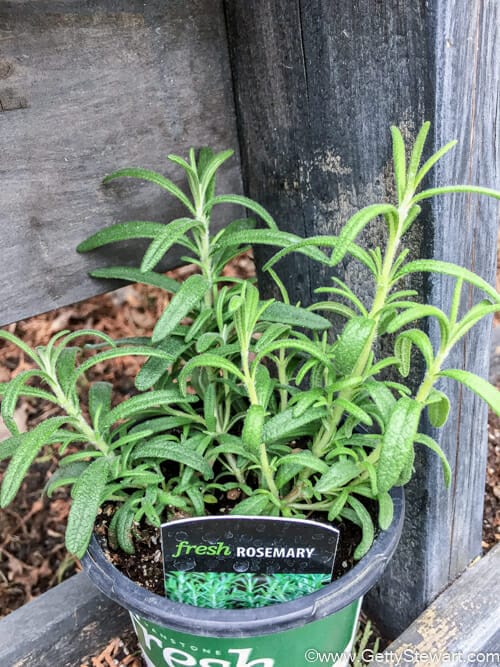How to Cut and Dry Rosemary
Rosemary is a fragrant woody herb that adds intense flavor to any savory dish. In it’s native, Mediterranean habitat it grows into large bushy plants, sometimes used as hedges! Here in the Canadian prairies (Hardiness Zone 3), where winter hits early and hard, it is often grown in small pots and treated as an annual.

Read more: How to Harvest Dill, Growing Herbs for Herbal Tea, Grow & Harvest Chives.
As a result, our rosemary is typically much smaller. Nonetheless, for the fullest growth and nicest shape possible, it’s good to cut back your rosemary. Not only does it promote new growth, but you get to harvest more rosemary to enjoy throughout the year.
For those with small pots of rosemary, here’s how to cut and dry it followed by some ideas of how to use rosemary.

How to Cut Rosemary
For best results, I cut one stem at a time, working my way around the plant – remember I’m talking about a small pot of rosemary, not a hedge!

It’s important to know that new growth will only come from green stems, not from woody stems. So, unless you want to cut back your rosemary forever, only make cuts on the new growth. And please, use scissors or pruning shears for clean cuts.

Cut the green stem just above where two leaves are growing, this will prompt two new shoots to grow. This helps to avoid tall spindly rosemary and will result in twice as much rosemary to harvest. Whoo Hoo! Here’s a little video that explains it all.
Repeat this process several times throughout the summer. Each time you do, you can use the rosemary fresh or dry it for use throughout the year.
How to Dry Rosemary
Here are a few different ways to dry rosemary after you wash it and dry it to remove surface moisture.
Paper Bag Method
If you have just a few sprigs of rosemary, toss them in a paper bag and store in a warm, dry, well ventilated room for two to three weeks.
Hanging Method
Bundle three or four sprigs of rosemary together and tie with kitchen twine. Label and hang to dry in a well ventilated room for two to three weeks.
Dehydrator Method
Lay rosemary sprigs on dehydrator trays with plenty of space between each sprig. Dehydrate at very low temperatures, 95°F or 35°C. It will likely take 8 to 10 hours depending on humidity levels. For faster drying remove the leaves from the stems, but that’s totally optional.
Oven Method
Ideally, herbs are dried at very low temperatures. You don’t want to bake them, you just want to remove the moisture from inside. When oven drying, set your oven to the lowest possible setting and keep an eye out on your herbs. Place sprigs on a parchment lined baking sheet and dry until rosemary feels brittle. Exact time will vary depending on your oven temp.
Microwave Method
Strip rosemary leaves from the stem and sandwich in a single layer between two pieces of paper towel. Place in microwave for 30 seconds at medium to high power. Take rosemary out of the microwave and allow to cool for 30 seconds. Test to see if any are dry and brittle. Remove those that are, rotate those that aren’t and return them to the microwave for another 30 seconds. Repeat until all leaves are dry.
How to Store Rosemary
Once your rosemary is completely dry and cooled from any heat treatment for at least one hour (so there’s no risk of condensation), I recommend storing it in it’s largest form. That means, do not break it down or crumble it. Leaving it as whole as possible will preserve the flavor much better and much longer. Crumble, rub it or cut it only when you’re ready to use it in a recipe for optimum flavor.
Store dried rosemary in a dry, dark and if possible cool location. A tightly sealed glass jar works best.
I keep a small spice jar in my kitchen cupboard for every day use. I refill it as needed from the dried rosemary stored in a jar in the basement where it’s slightly cooler, dry and dark.
If stored well, you can expect the flavor and color to last six months to a year. It’s safe to use longer than that, but flavor and color will deteriorate.
How to Use Rosemary
Use whole sprigs, dried or fresh, in recipes that can handle rosemary’s aromatic almost pine like flavor. It’s fantastic with roasted root vegetables or hardy beef stew. It’s also a great addition to grilled or roasted meat, wild game or poultry. Baked breads also taste heavenly with a bit of rosemary. Try rosemary focaccia, baked pita crisps or garlic bread topped with a little rosemary salt or rosemary herb butter.

What’s your favorite way to enjoy rosemary? Comment below or take a photo and tag #getgettys so I can see and like your creations.

Be confident growing and using herbs.
With NO ads, and all the best tips & recipes in one convenient place! From Garden to Table: Everyday Cooking with Herbs.
65 recipes & preserves + practical tips…
- how to grow herbs
- step-by-step harvesting and preserving instructions
- tantalizing tea and beverage recipes
- mouth watering appetizers, salads, mains, and desserts
- solve all your herb FAQs
Available in ebook and paperback formats.
Select, store and serve seasonal food for everyday cooking with Getty. Getty is a food educator and Professional Home Economist, who loves sharing tips and recipes following the seasons from her Canadian kitchen. Sign up to get seasonal tips and recipes delivered to your inbox. Learn more about Getty or check out her books and pdf guides.



Thanks, Getty. Super-helpful and just what I needed to know!! (especially helpful was the video and your showing WHERE to make the cut properly.) This summer my favourite ‘rosemary dish” is a deep-dish focaccia, topped with thin fresh tomato slices and rosemary, also topped with some coarse ground salt. Makes for a very pretty presentation, and my friends have really enjoyed it.
Hi Bev,
I’m glad you found the info helpful. I love Rosemary Focaccia, definitely a treat.
All the best,
Getty